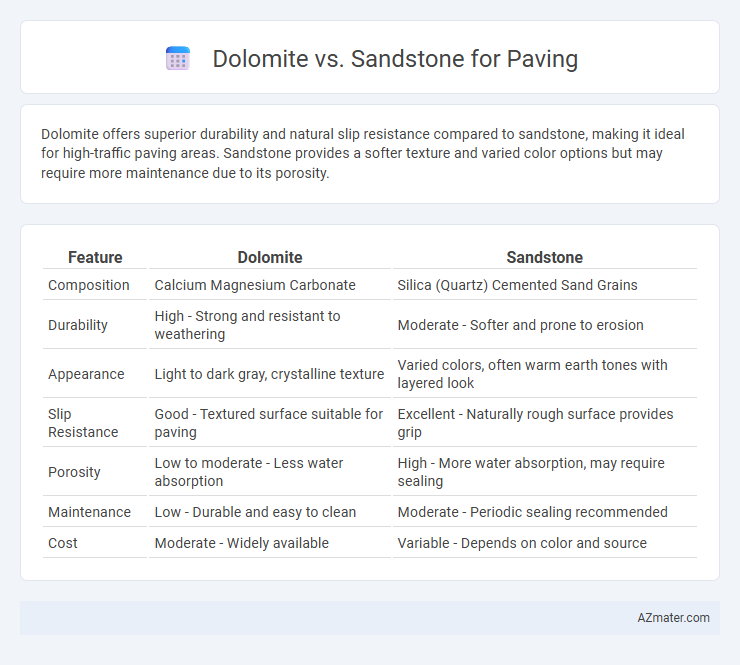Dolomite offers superior durability and natural slip resistance compared to sandstone, making it ideal for high-traffic paving areas. Sandstone provides a softer texture and varied color options but may require more maintenance due to its porosity.
Table of Comparison
| Feature | Dolomite | Sandstone |
|---|---|---|
| Composition | Calcium Magnesium Carbonate | Silica (Quartz) Cemented Sand Grains |
| Durability | High - Strong and resistant to weathering | Moderate - Softer and prone to erosion |
| Appearance | Light to dark gray, crystalline texture | Varied colors, often warm earth tones with layered look |
| Slip Resistance | Good - Textured surface suitable for paving | Excellent - Naturally rough surface provides grip |
| Porosity | Low to moderate - Less water absorption | High - More water absorption, may require sealing |
| Maintenance | Low - Durable and easy to clean | Moderate - Periodic sealing recommended |
| Cost | Moderate - Widely available | Variable - Depends on color and source |
Introduction to Dolomite and Sandstone Paving
Dolomite paving offers exceptional durability and resistance to weathering due to its high magnesium carbonate content, making it ideal for heavy traffic areas and outdoor use. Sandstone paving provides natural slip resistance and a variety of warm earthy tones, enhancing aesthetic appeal for garden paths and patios. Both materials deliver unique benefits, with dolomite excelling in hardness and longevity, while sandstone stands out for its textured surface and color versatility.
Geological Origins: Dolomite vs Sandstone
Dolomite originates from a sedimentary rock composed mainly of calcium magnesium carbonate, formed through the chemical alteration of limestone under high-pressure conditions. Sandstone consists of compacted sand-sized mineral particles, primarily quartz and feldspar, deposited in ancient riverbeds or coastal environments. The geological formation processes of dolomite result in greater hardness and resistance to weathering compared to the more porous and layered structure of sandstone.
Physical Characteristics Comparison
Dolomite exhibits higher density and greater hardness compared to sandstone, making it more resistant to wear and impact for paving applications. Sandstone's porous structure results in superior water permeability but reduced durability under heavy traffic or extreme weather conditions. The compressive strength of dolomite generally surpasses sandstone, providing enhanced load-bearing capacity ideal for high-traffic paving surfaces.
Color and Texture Differences
Dolomite offers a more uniform, light gray to cream color with a smooth, fine-grained texture, making it ideal for sleek, modern paving designs. Sandstone typically presents a broader color range, from warm reds and browns to yellows and tans, featuring a coarser, layered texture that adds natural rustic charm to outdoor spaces. The color stability of dolomite under sunlight contrasts with sandstone's tendency to develop richer hues over time, influencing long-term aesthetic choices for paving projects.
Durability and Weather Resistance
Dolomite exhibits superior durability and weather resistance compared to sandstone, making it ideal for paving in regions with harsh climates. Its high density and low porosity contribute to excellent resistance against freeze-thaw cycles and erosion, ensuring long-lasting performance. Sandstone, while aesthetically pleasing, tends to be more porous and susceptible to weathering, requiring more maintenance over time.
Maintenance Requirements
Dolomite paving requires minimal maintenance due to its dense structure and resistance to weathering, reducing the need for frequent sealing or repairs. Sandstone, being more porous and softer, demands regular sealing and careful cleaning to prevent staining and erosion from environmental exposure. Proper maintenance of sandstone includes periodic resealing and gentle cleaning methods to preserve its aesthetic and structural integrity.
Slip Resistance and Safety
Dolomite offers superior slip resistance compared to sandstone due to its rougher texture and natural hardness, making it safer for wet or high-traffic paving areas. Sandstone, while visually appealing, tends to become slippery when wet because of its smoother surface and higher porosity, increasing the risk of slips and falls. Choosing dolomite for paving projects enhances safety by providing better grip and reducing slip hazards, especially in outdoor environments prone to moisture.
Cost Analysis: Dolomite vs Sandstone
Dolomite typically offers a lower initial cost compared to sandstone, making it a budget-friendly option for paving projects. Sandstone generally commands a higher price due to its aesthetic appeal and durability, which can lead to lower maintenance expenses over time. When comparing overall cost-effectiveness, evaluating long-term durability and maintenance requirements alongside upfront material costs is essential for making an informed decision between dolomite and sandstone paving.
Best Applications for Each Material
Dolomite offers superior durability and resistance to weathering, making it ideal for high-traffic outdoor paving such as driveways, patios, and walkways in regions with harsh climates. Sandstone provides natural slip resistance and a textured surface, making it perfect for decorative garden paths, pool surrounds, and areas requiring aesthetic appeal and safety. The choice depends on specific application needs: dolomite excels in strength and longevity, while sandstone is favored for its visual warmth and non-slip properties.
Conclusion: Choosing the Right Stone for Your Project
Dolomite offers exceptional durability and resistance to weathering, making it ideal for high-traffic paving areas requiring long-lasting performance. Sandstone provides a natural aesthetic with diverse color options, best suited for decorative and low-traffic spaces emphasizing visual appeal. Selecting between dolomite and sandstone depends on balancing the need for strength and longevity against design preferences and maintenance requirements.

Infographic: Dolomite vs Sandstone for Paving
 azmater.com
azmater.com